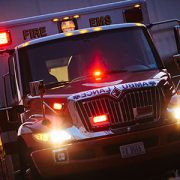Accident or assault? Pediatric firearm injuries differ by age

According to a retrospective, cross-sectional study led by Children’s researchers, younger kids are more likely to be shot by accident, and odds are higher that older youths are victims of an assault involving a firearm.
An increasing number of children are injured by firearms in the U.S. each year, but the reasons these injuries happen vary. According to a new retrospective, cross-sectional study led by Children’s researchers and presented at the American Academy of Pediatrics (AAP) 2018 National Conference & Exhibition, firearm injuries vary by the intent of the person discharging the weapon. Younger kids are more likely to be shot by accident, and odds are higher that older youths are victims of an assault involving a firearm. Efforts to protect children from firearm-related injuries should factor in these differences in intent as legislation and policies are drafted, the study team suggests.
Researchers led by Shilpa J. Patel, M.D., MPH, Children’s assistant professor of pediatrics and emergency medicine, reviewed data aggregated in the Nationwide Emergency Department Sample from 2009 to 2013 looking for emergency department visits to treat firearm-related injuries suffered by children and adolescents 21 and younger. They excluded emergency department visits for firearm-related injuries attributed to air, pellet, BB or paintball guns.
Firearm-related injuries are a leading cause of injury and death for U.S. children. Some 111,839 children and youth were treated in emergency departments for firearm-related injuries, or 22,367 per year when averaged over the five-year study period. Nearly 63 percent of these youths were injured by accident; 30.4 percent were victims of assault; 1.4 percent used a firearm to injure themselves. Of note:
- 89.3 percent were male
- Their mean age was 18 (67.3 percent 18 to 21; 27.9 percent 13 to 17; 4.8 percent younger than 12)
- 1 percent were discharged from the emergency department
- 30 percent had injuries grave enough to trigger hospital admission and
- 1 percent died from their injuries.
“Children younger than 12 were more likely to be shot by accident. By contrast, we found that the odds of experiencing firearm-related injuries due to assault were higher for youths aged 18 to 21,” Dr. Patel says. “Physicians can play a powerful role in preventing pediatric firearm-related injuries by routinely screening for firearm access and speaking with families about safe firearm storage and violence prevention,” she adds.
Some 52.1 percent of children with firearm-related injuries lived with families whose median household incomes exceeded $56,486.
American Academy of Pediatrics National Conference & Exhibition presentation
- “Emergency department visits for pediatric firearm-related injury: by intent of injury.”
Shilpa J. Patel, M.D., MPH, assistant professor of pediatrics and emergency medicine and lead author, Gia M. Badolato, MPH, senior clinical research data manager and study co-author, Kavita Parikh, M.D., MS, associate professor of pediatrics and study co-author, and Monika K. Goyal, M.D., MSCE, assistant division chief and director of Academic Affairs and Research in the Division of Emergency Medicine and study senior author, all of Children’s National Health System; and Sabah F. Iqbal, M.D., medical director, PM Pediatrics, study co-author.










